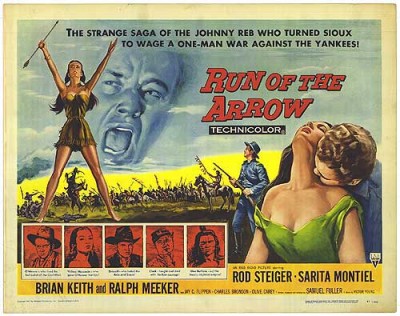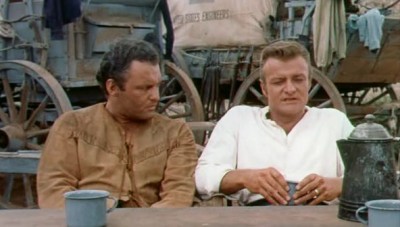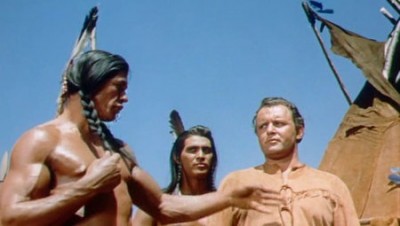| Reviews & Columns |
|
Reviews DVD TV on DVD Blu-ray 4K UHD International DVDs In Theaters Reviews by Studio Video Games Features Collector Series DVDs Easter Egg Database Interviews DVD Talk Radio Feature Articles Columns Anime Talk DVD Savant Horror DVDs The M.O.D. Squad Art House HD Talk Silent DVD
|
DVD Talk Forum |
|
|
| Resources |
|
DVD Price Search Customer Service #'s RCE Info Links |
|
Columns
|
|
|
Run of the Arrow
Recent Confederate flag proponents who decry its removal from the South Carolina State House should take note of Samuel Fuller's underrated Western masterpiece Run of the Arrow, newly available for the first time on DVD. O'Meara, a Confederate soldier played by Rod Steiger, loses all sense of identity and purpose after the South is defeated in the Civil War, and he decides to head to the "Far West" to join the Sioux tribe, who live on land not yet claimed by the U.S. Fuller's hard-hitting adventure film stresses that O'Meara is a sore loser who cannot accept losing a way of life and an institution- slavery- that aren't reflective of the true realities of diversity in America. In this way, Fuller's Western, released in 1957, is a forward-looking piece of art that, in it's own crudely appealing way, stresses the importance of acceptance of all cultures in the United States.
Run of the Arrow is timeless in its appeal to racial diversity and America's collective identity as a Melting Pot of cultures. Modern day Confederate sympathizers and apologists should take note of O'Meara's struggle with his own backwards way of thinking.
The film opens with O'Meara firing the final shot of the Civil War in Appomattox, Virginia. Like much of Fuller's work, and similar to many of the best Western films that were being made through the 1950s, Run of the Arrow is steeped in American mythology. There is no sense of real history in the film: The Sioux, the tribe that O'Meara defects to, were not a desert tribe, where the majority of the film takes places, and his presence at the last battle of the Civil War in Appomattox, where he fires the final bullet and then witnesses first-hand General Lee acknowledging the loss of the South to General Grant, are the kinds of oversimplifications and outright fabrications that modern audiences and historically-minded people will deride as false. But Fuller's work has always been more concerned with visceral broad strokes, and this only adds to the tough, hard-boiled nature of Run of the Arrow.
 Steiger as O'Meara seethes with convincing bitterness after the South loses the war. As a Confederate, O'Meara's sense of self is tied to his identity as a Southerner, and when his side loses the war, he calls his own existence into question. After witnessing Lee personally concede to Grant, O'Meara goes home in disgust. A key moment occurs during this early section of the film, when O'Meara's mother, her voice tinged with the same Irish-Southern warble that Steiger inexplicably affected for his role, pleads for her son to stay home, and to accept that the South and America are entering a new historical period as a single nation. But O'Meara, setting up his decision to defect from the U.S. in order to join the "Savages" of the West, asks his mother, "Where's your pride, ma?" after which he tells her, "The savages have more pride than we do."
Steiger as O'Meara seethes with convincing bitterness after the South loses the war. As a Confederate, O'Meara's sense of self is tied to his identity as a Southerner, and when his side loses the war, he calls his own existence into question. After witnessing Lee personally concede to Grant, O'Meara goes home in disgust. A key moment occurs during this early section of the film, when O'Meara's mother, her voice tinged with the same Irish-Southern warble that Steiger inexplicably affected for his role, pleads for her son to stay home, and to accept that the South and America are entering a new historical period as a single nation. But O'Meara, setting up his decision to defect from the U.S. in order to join the "Savages" of the West, asks his mother, "Where's your pride, ma?" after which he tells her, "The savages have more pride than we do."
On his journey through the West, O'Meara sees vultures circling above him in the Technicolor-blue sky, and discovers Walking Coyote, a scout for the U.S. military, passed out drunk on the ground. After they are captured by a band of Sioux who are also wandering through the desert, O'Meary is then put through his first test as an American defector: he must complete the run of the arrow, in which one of the Sioux warriors fires an arrow into the air, and both O'Meara and Walking Coyote must march barefoot to the point where the arrow has landed, after which they are given a head start to run for their lives as the Sioux proceed to try to hunt them down and kill them. The run is a fight for survival that tests the will and conviction of O'Meara's status as a defector of the United States. Do those who deflect the increasingly accepted view that the Confederate flag is a symbol of hatred and slavery also have the same kind of conviction? Fuller's film calls the bluff of those who have used the Confederate flag as a signifier of their own willful ignorance.

As a film about conflicting national identities, one of the most forceful moments in Run of the Arrow occurs when a Union soldier talks to a Confederate and calls into question the nature of the Southern pride that drives O'Meara to defect. The Yankee soldier sneers sarcastically, "Free, white, and Christian. Putting pillowcases over their heads and lynching black people!" And similar to modern day Confederate flag supporters who distance themselves from the symbol's dark past, the Southern soldier replies, "I don't know what you're talking about." Says the Yankee soldier in return, "Yes. It's always the other guy." Even in the racially-charged 1950s, when Jim Crow laws were the norm, Fuller foresaw the desperate, always false revisionism that is frequently used today to deflect the Confederate flag's association with racism and violence. As a filmmaker, Fuller was completely aware of the pain caused by racism during his time.

In the end, O'Meara reconciles his identity by realizing that, deep down, regardless of being a Southerner, he is first and foremost an American. This is a far more honest ending than the one presented in Kevin Costner's Dances with Wolves, a 1990 film that suspiciously shares a remarkably similar plot with Run of the Arrow. In that tepid, overly long revisionist Western, Costner plays a Confederate soldier who joins a band of the Sioux and falls in love with one of its female tribal members. But that film, which also shows its main character rejoining the side of the American Cavalry, trivializes the Sioux characters after making a great effort, and failing, to humanize Native Americans in response to decades of Indian characters being forced into the Savage archetype that has been so prevalent in the Western genre. The Indians who appear in Run of the Arrow, many of whom were played by white actors, are viewed from Fuller's outsider perspective with sympathy, even when these characters are given the marauding, war-whooping characteristics that are informed by the West's mythological past.
Run of the Arrow is anarchic and bloody- notice a violent close-up in the film where a Union soldier takes a bullet to the head; this is one of the earliest examples of a squib being used in a film. Like nearly all Samuel Fuller movies, close-ups are used to create frantic, chaotic moments that almost become abstract. Steiger's demeanor and his performance give the film the same sort of chaos. His bitter performance is as tough as they come. He plays a Southerner who, for reasons never fully fleshed out, speaks with a bad Irish brogue. His performance in Run of the Arrow is so great for all the reasons that would make most performances terrible. He mumbles his dialogue like a badly trained Actor's Studio reject, and his fat, dark, greasy face is constantly at odds with the bright, beautiful, Technicolor Utah landscape that acts as the film's backdrop. In Fuller's own words, taken from his endlessly entertaining tall-tale autobiography A Third Face: My Tale of Writing, Fighting, and Filmmaking, he cast Steiger against the advice of R.K.O. Pictures because he liked the actor's "Sour face and fat ass." The studio wanted to cast the handsomer, more successful box office draw Gary Cooper, but Fuller relented, and knew exactly how to utilize Steiger's rough edges.

The DVD:
Video:Run of the Arrow is presented in its original 1.78:1 aspect ratio, in all of its vivid Technicolor beauty. While grainy, the film has transferred nicely to DVD. The disc is a "made to order" title from Warner Archives, which seems to diminish the picture quality by a very small margin, but, strangely, the grain and occasional scratch adds to the film's appealingly rough and tough quality.
Audio: Run of the Arrow is presented with a Mono soundtrack, which means that the audio is somewhat flat on multiple speaker systems, but it is evenly distributed and immersive. However, using only one audio track does not detract from the experience of watching the film.
Extras: Sadly, the DVD has no extra features.
Final Thoughts:
Run of the Arrow was ahead of its time in the way it questions the dubious convictions and logic of all of the Confederacy sympathizers who have reared their heads in the media over the past year. The film is also forward-looking in its admittedly simplistic but sympathetic portrayal of Native Americans, which was extremely rare for Western films of its time. Those familiar with Samuel Fuller's work will expect a desceptively crude, violent film that strives to make nuanced comments about conflicting American identities. Run of the Arrow also speaks to our current times in the way O'Meara mirrors the conflicting collective identity of Confederate flag supporters who espouse their right to fly the Confederate flag without having the ability to acknowledge that the ideology behind it was created to counter the American ideals they take for granted. If only they all had the conviction of O'Meara to put their money where their mouths are. The DVD is disappointingly bare of any features that would enhance the viewing experience for those who have never seen Fuller's work, but as an example of his best work, the disc is still worth owning.
|
| Popular Reviews |
| Sponsored Links |
|
|
| Sponsored Links |
|
|
| Release List | Reviews | Shop | Newsletter | Forum | DVD Giveaways | Blu-Ray | Advertise |
|
Copyright 2024 DVDTalk.com All Rights Reserved. Legal Info, Privacy Policy, Terms of Use,
Manage Preferences,
Your Privacy Choices | |||||||














